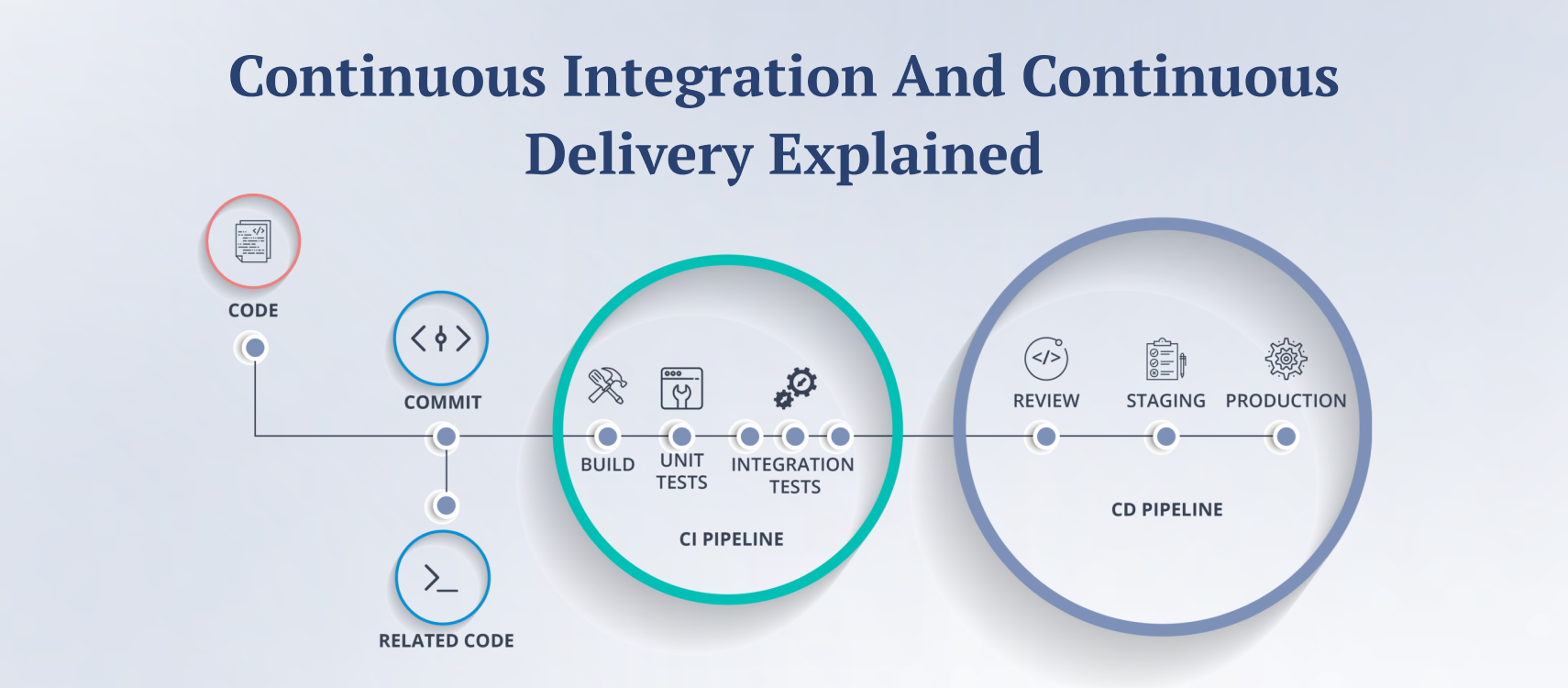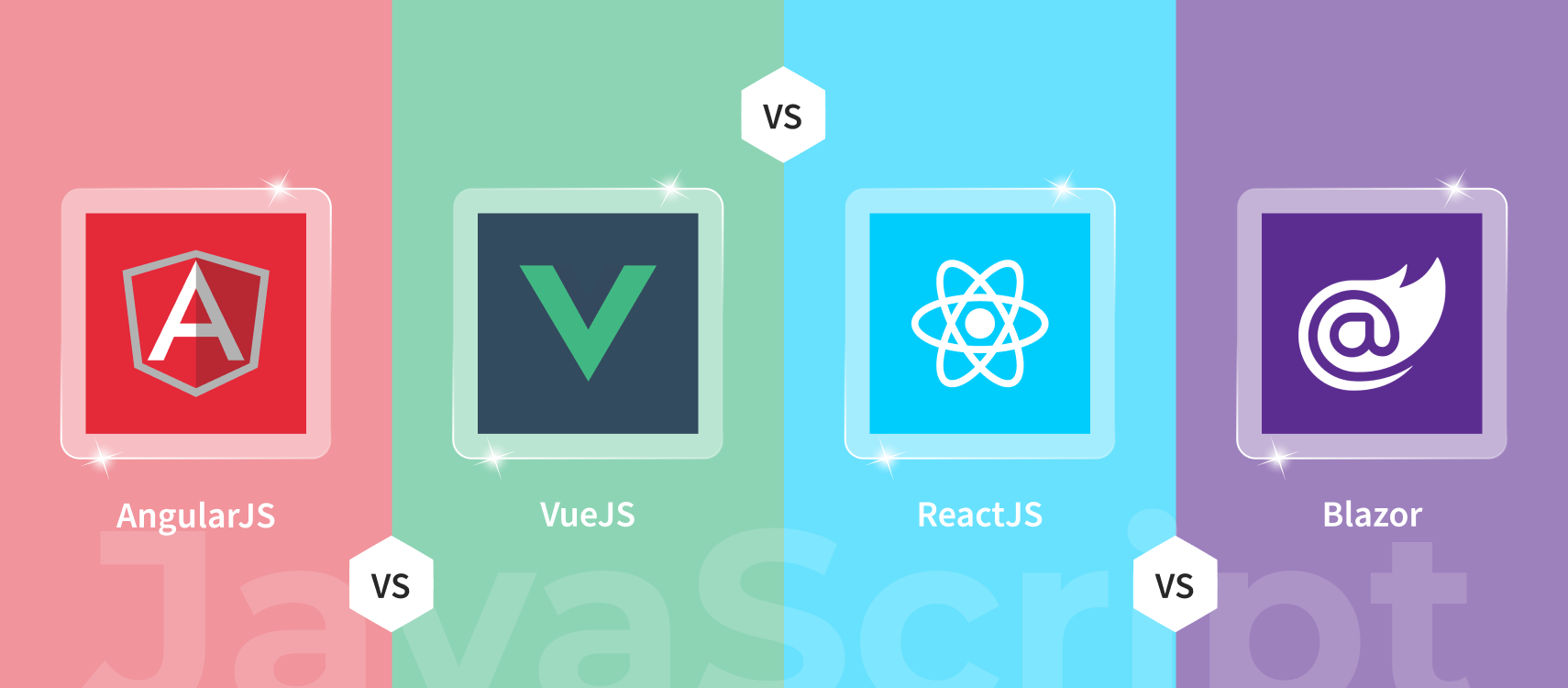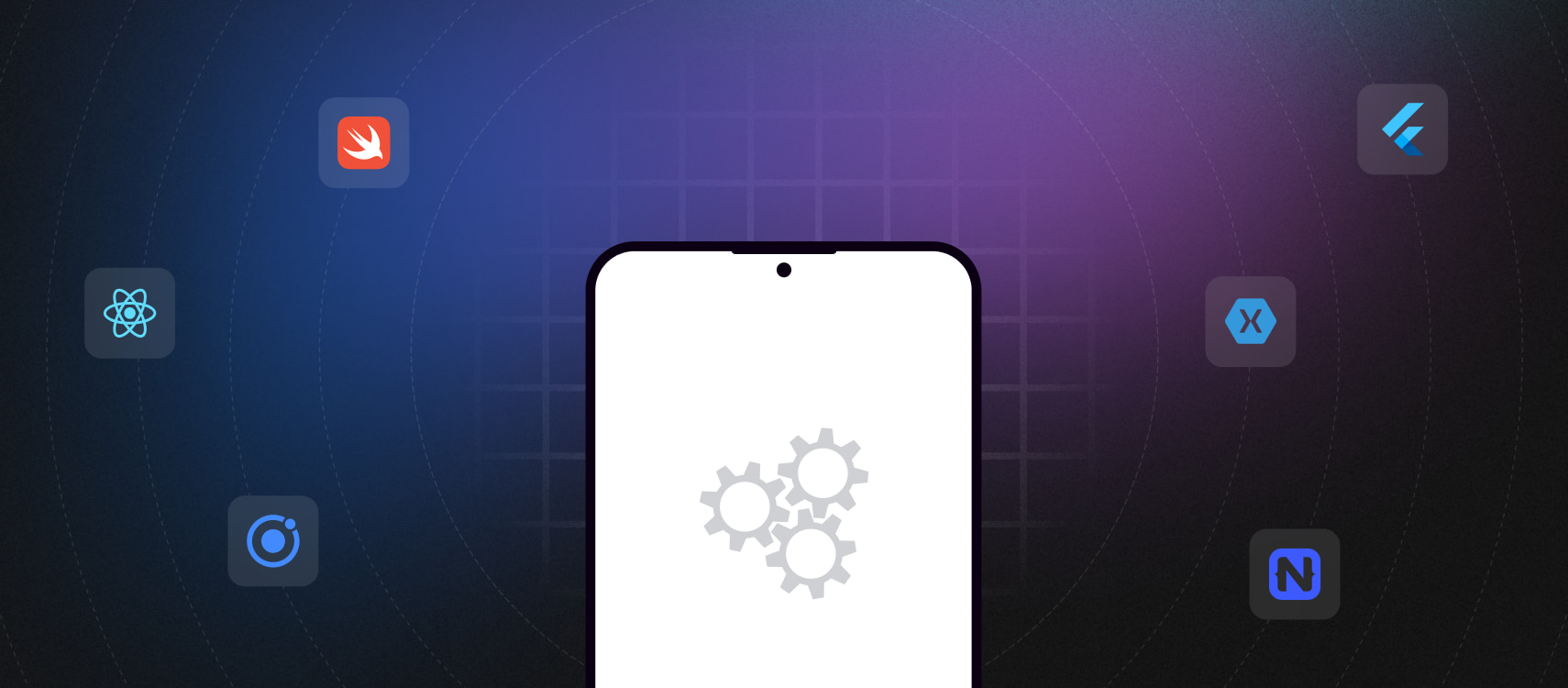Table of Contents
- What is CI/CD?
- Why Does CI/CD Matter?
- What is Continuous Integration (CI)?
- What is Continuous Delivery (CD)?
- What is Continuous Deployment?
- The Benefits of CI/CD Implementation
- CI/CD Tools and Technologies
- Why EncodeDots CI/CD?
- Summarising
- FAQs about CI/CD
What is CI/CD?
CI/CD stands for Continuous Integration and Continuous Delivery/Deployment. It’s a modern approach to software development that helps teams release new features, bug fixes, and improvements faster while reducing errors.
- Continuous Integration (CI): Developers regularly merge their code changes into a shared repository. Each update triggers automated builds and tests, making it easier to catch issues early before they grow into bigger problems.
- Continuous Delivery (CD): Once the code has passed all tests, it’s automatically prepared for release. The software is always in a “ready-to-deploy” state, but the actual push to production still requires manual approval.
- Continuous Deployment (also CD): This takes automation one step further. Every change that passes testing is automatically deployed to the live environment without human intervention.
Together, these practices create what’s known as CI/CD pipelinea step-by-step process that ensures new software updates move smoothly from development to production. CI/CD is a cornerstone of DevOps and agile practices because it encourages faster releases, better collaboration, and more reliable software.
Why Does CI/CD Matter?
Building software today isn’t just about writing code; it’s about how quickly and reliably that code can reach users. That’s where CI/CD comes in.
With CI/CD, much of the development process is automated. Code is tested as soon as it’s written, updates are packaged automatically, and deployments happen with far less manual effort. This means new features, improvements, and bug fixes reach customers faster without sacrificing quality.
Another advantage is early problem detection. Instead of discovering issues late in the release cycle, CI/CD catches them during development, when they’re easier and cheaper to fix. This not only saves time but also keeps software more stable in production.
Finally, CI/CD shortens the feedback loop. Teams can release smaller updates more often, listen to user feedback, and adjust quickly. For businesses, this translates into products that stay aligned with customer needs and adapt smoothly to market changes.
In short, CI/CD helps teams move fast, stay flexible, and deliver reliable software that users can trust.
What is Continuous Integration (CI)?
Continuous Integration, or CI, is all about making teamwork in software development easier. Instead of waiting days or weeks to combine everyone’s work, developers regularly merge their changes into a shared codebase. Each time they do, automated tests run in the background to check for bugs, security issues, or conflicts.
This habit of frequent integration means problems are spotted early, when they’re quicker and cheaper to fix. It also helps prevent the dreaded “last-minute merge conflicts” that often happen when multiple developers are working on the same project. In short, CI keeps the codebase clean, stable, and always ready for the next step.
What is Continuous Delivery (CD)?
Continuous Delivery, or CD, takes things further by making sure software is always in a “ready-to-release” state. Once the code has passed the CI tests, CD packages it with everything needed to run in any environment, whether that’s staging, testing, or production.
The benefit? Teams don’t have to scramble or do manual prep work when it’s time to release. They can deploy updates whenever they choose, with confidence that the software will work as expected. For some teams, this process is taken a step further into Continuous Deployment, where updates go live automatically without human approval.
What is Continuous Deployment?
Continuous Deployment is the final stage of a mature CI/CD pipeline. It builds on the foundation of Continuous Integration and Continuous Delivery by fully automating the release process. Instead of requiring manual approval before deployment, every change that passes the automated tests is pushed directly into the production environment, where it becomes available to customers.
The purpose of Continuous Deployment is to remove the delays and bottlenecks caused by manual processes. In traditional release cycles, operations teams often spend significant time coordinating deployments, which slows down delivery and increases the chance of human error. Continuous Deployment solves this by extending the automation already in place with Continuous Delivery, ensuring that code flows seamlessly from development to production.
In practice, this means that a developer can make a change to an application, commit it, and if it passes all the automated testing stages, it could be live within minutes. This creates a faster feedback loop, allowing teams to quickly see how users respond to new features or fixes and make improvements in real time. It also reduces risk, because updates are released in smaller, incremental pieces rather than in large, complex releases.
Because there is no manual gate before production, Continuous Deployment depends heavily on strong test automation. The testing framework must be able to cover everything from functionality and performance to security. This often requires significant upfront investment, since automated tests need to be designed to handle a wide variety of scenarios. However, once established, Continuous Deployment provides a powerful way to deliver reliable software at high speed, making it easier for teams to innovate continuously without slowing down.
The Benefits of CI/CD Implementation
Adopting Continuous Integration and Continuous Delivery (CI/CD) isn’t just a technical upgrade it transforms the way teams build, release, and improve software. By automating and streamlining critical parts of the development pipeline, organizations see faster delivery, fewer errors, and stronger collaboration. Here are ten key benefits that highlight why CI/CD has become a cornerstone of modern software development.
1. Faster Release Cycles
CI/CD pipelines allow teams to push updates into production quickly and consistently. Instead of waiting for large release windows, changes can be delivered in smaller, frequent batches, giving businesses the ability to respond faster to user needs and market demands.
2. Early Bug Detection
Automated builds and tests run every time code is integrated. This helps uncover issues at the earliest possible stage, when they are easier and cheaper to fix, rather than at the end of a long development cycle.
3. Improved Software Quality
Because testing is continuous and automated, every release passes through multiple quality checks before it goes live. This leads to more stable, reliable applications and fewer problems for end users.
4. Reduced Deployment Risks
Releasing software in smaller, incremental updates makes deployments less risky. If something does go wrong, it’s easier to trace the issue, roll back changes, and minimize the impact on customers.
5. Better Collaboration Across Teams
CI/CD breaks down silos between development and operations. Everyone works within the same automated pipeline, which improves communication, reduces handoff delays, and fosters a DevOps culture of shared responsibility.
6. Increased Developer Productivity
Automation takes care of repetitive tasks like testing, packaging, and deploying. This frees developers to focus on higher-value work such as building new features, improving user experience, or solving complex problems.
7. Reliable Delivery Timelines
By removing manual bottlenecks and making deployments predictable, CI/CD makes it easier to plan and meet deadlines. Work is broken into manageable chunks, making timelines more realistic and less stressful.
8. Enhanced Customer Experience
With fewer bugs making it into production and faster delivery of new features, users enjoy a smoother, more satisfying product experience. This builds trust, loyalty, and a stronger reputation for the organization.
9. Continuous Feedback and Improvement
Every release provides immediate feedback both from automated monitoring tools and from real users. Teams can quickly adapt to feedback, prioritize improvements, and evolve the product continuously.
10. Greater Business Agility
Ultimately, CI/CD gives organizations the ability to adapt to change with confidence. Whether it’s responding to customer requests, fixing security issues, or experimenting with new features, businesses can move quickly without sacrificing quality.
CI/CD Tools and Technologies
Implementing CI/CD successfully depends on the right set of tools and technologies. These solutions help development teams automate builds, streamline testing, and accelerate deployments while ensuring software quality and reliability. Below are 10 widely used CI/CD tools that have become essential for modern DevOps teams.
1. Jenkins – The Most Popular CI/CD Server
Jenkins It is one of the most established open-source automation servers in the CI/CD ecosystem. It provides thousands of plugins that integrate with almost any tool in the software development lifecycle. Teams can use Jenkins to build customized pipelines, automate testing, and manage deployments across multiple environments. Its flexibility makes it a favorite for enterprises managing complex projects.
2. Travis CI – Cloud-Based CI for GitHub Projects
Travis CI is a cloud-native CI/CD solution designed for GitHub repositories. It’s known for its simplicity and quick setup. Developers can easily test their applications across different programming languages, frameworks, and operating systems. Travis CI also supports parallel builds, which speed up the feedback loop for teams working on fast-paced projects.
3. CircleCI – Scalable and Container-Friendly CI/CD
CircleCI It is a flexible, cloud-hosted CI/CD platform that offers strong support for containerized applications using Docker. Its powerful caching mechanism and resource-class configurations allow teams to optimize build times. With built-in insights and analytics, CircleCI helps developers monitor performance and scale pipelines as projects grow.
4. GitLab CI/CD – Integrated DevOps Platform
GitLab CI/CD stands out because it’s built directly into GitLab’s version control system. Unlike other platforms that require multiple integrations, GitLab offers source code management, issue tracking, CI/CD, and security tools in one environment. This all-in-one approach simplifies project workflows and reduces the need for external plugins or third-party services.
5. AWS CodePipeline – Managed CI/CD in the Cloud
AWS CodePipeline is Amazon’s fully managed CI/CD service. It automates build, test, and deployment stages by integrating seamlessly with other AWS services like CodeBuild, CodeDeploy, and CloudFormation. This makes it an excellent choice for organizations already running their infrastructure on AWS.
6. Azure DevOps – Microsoft’s Complete CI/CD Suite
Azure DevOps provides a comprehensive suite for managing the entire software lifecycle. It supports continuous integration, continuous delivery, version control, and project management within one platform. Teams benefit from its flexibility to deploy applications to both Microsoft Azure and other cloud platforms.
7. Bitbucket Pipelines – CI/CD for Atlassian Users
Bitbucket Pipelines is Atlassian’s built-in CI/CD solution. It integrates tightly with Bitbucket repositories, making it a convenient option for teams already using Jira or Confluence. With simple YAML configurations, developers can define workflows, automate deployments, and monitor pipeline execution easily.
8. TeamCity – Enterprise-Grade CI/CD
TeamCity JetBrains is a powerful CI/CD platform that offers advanced features like build history, test intelligence, and parallel builds. It integrates with a wide range of tools and IDEs, making it ideal for enterprise-scale projects. TeamCity also provides detailed reporting to track test results and code quality trends.
9. Bamboo – CI/CD by Atlassian
Bamboo is another tool from Atlassian that integrates well with Jira, Bitbucket, and Confluence. Unlike Bitbucket Pipelines, Bamboo provides more advanced deployment workflows, including support for complex build processes. It’s often used by teams that need tighter integration with the Atlassian ecosystem.
10. ArgoCD – GitOps-Focused Continuous Delivery
ArgoCD It is a Kubernetes-native continuous delivery tool that leverages GitOps principles. It automatically synchronizes the desired application state stored in Git repositories with the actual running environment. ArgoCD is ideal for teams managing microservices and containerized workloads in Kubernetes clusters.
Why EncodeDots CI/CD?
One of the biggest challenges organizations face when adopting CI/CD is the need to piece together multiple tools just to build a complete pipeline. Many existing platforms depend heavily on third-party integrations, which often means managing a complex and expensive toolchain. For example, teams may use GitHub or Bitbucket for source code management, then connect that to a separate testing tool, which further links to a CI engine, followed by deployment solutions like Puppet or Chef on top of additional security and monitoring tools.
This fragmented setup creates overhead. Instead of focusing energy on delivering great software, teams spend valuable time maintaining and troubleshooting toolchains. The result is slower delivery, higher costs, and more operational friction.
EncodeDots simplifies this process. As a single platform that supports the entire DevSecOps lifecycle, EncodeDots brings together source code management, testing, continuous integration, continuous deployment, security, and monitoring all in one environment. By eliminating the need for multiple disconnected tools, EncodeDots gives organizations a streamlined, efficient, and cost-effective way to achieve full CI/CD.
With EncodeDots, your teams can focus less on managing tools and more on what matters most: delivering reliable software, faster.
Summarising
CI/CD has become a cornerstone of modern software development because it transforms the way teams build, test, and deliver applications. Automating repetitive processes, ensuring continuous testing, and enabling faster deployments help organizations reduce errors, shorten release cycles, and improve collaboration across development and operations. Whether it’s Continuous Integration keeping the codebase clean, Continuous Delivery ensuring readiness, or Continuous Deployment enabling real-time updates, these practices collectively ensure that software reaches users faster and with higher quality.
Instead of managing a fragmented toolchain, businesses can benefit from integrated solutions like EncodeDots, which unify the entire DevSecOps lifecycle into one streamlined platform. By reducing complexity and overhead, we can focus on innovation rather than managing tools. The result is a faster, more reliable delivery pipeline that aligns with customer needs, strengthens product quality, and enhances business agility in today’s competitive digital landscape.










